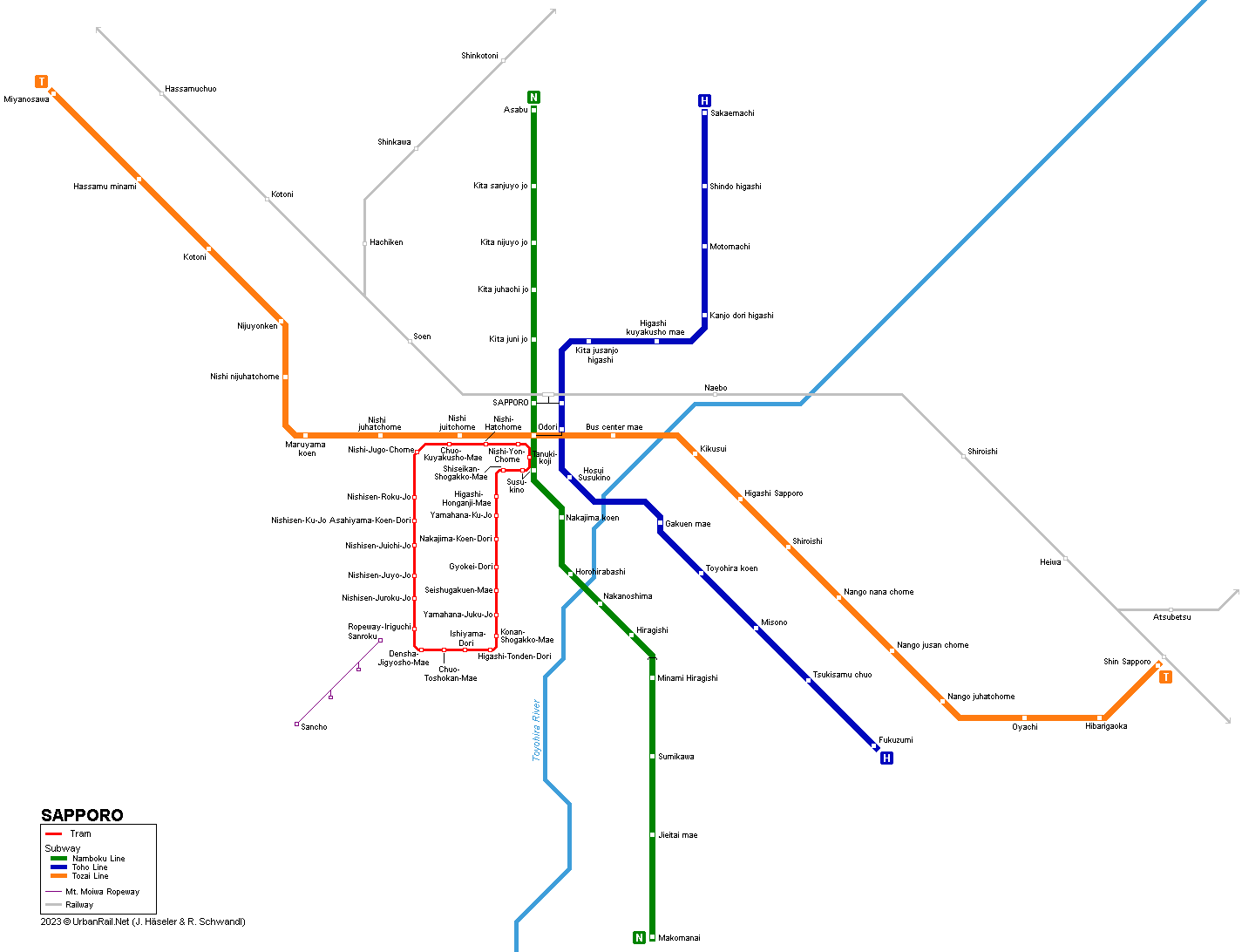
|
[ UrbanRail.Net ] [ Europe ] [ Americas ] [ Asia ] [ Africa ] [ Oceania ] [ News ] [ Books ] [ Links ] |
|
SAPPORO
|
| Japan |

|
SUBWAY
|
|
Currently, the system has a total length of 48 km with 46 stations and three lines. Sapporo also maintains a 9 km long streetcar line which serves the southwest of the city and intersects with the subway at Susukino. It has 1067 mm gauge, and 24 stops.
|
| Namboku Line |
|
14.3 km, third rail power supply 16 Dec 1971:
Makomanai
- Kita nijuyo-jo (12.1 km, 4.4 km elevated) |
|
|
| Tozai Line |
|
20.1 km, overhead line 10 June
1976: Kotoni
- Shiroishi (9.9 km) |
|
|
| Toho Line |
|
13.6 km, overhead line 02 Dec 1988:
Sakaemachi - Hosui-Susukino (8.1 km) |
|
|
|
|
|
Book |
|
NEW: METROS & TRAMS in JAPAN Vol. 2: Nord- und Zentraljapan | North & Central Japan Metros in Sapporo, Sendai and Nagoya as well as trams in Hakodate, Toyama, Fukui, Takaoka, Toyohashi, Kochi, Matsuyama plus various other urban rail systems in North & Central Japan 144 pages;
Network maps; ca. 300 colour photos The second volume of our trilogy about urban rail systems in Japan covers all the systems in North and Central Japan, from the metros in Sapporo, Sendai and Nagoya to the numerous tram networks and various private suburban railways. This volume also includes all the cities with urban rail systems on the islands of Shikoku and Okinawa. As usual, the book is illustrated with a large number of recent colour photos and detailed network maps. |
|
Subway
Photos
|
|
STREETCAR |
|
9 km loop line, 24 stops, 1067 mm gauge 20 Dec 2015: Loop completed between Nishi-Yon-chome and Susukino (0.4 km) |
|
|
|
|
| JR HOKKAIDO SUBURBAN RAIL |
|
Links
|
|
Sapporo City Transportation Bureau Sapporo Subway at Wikipedia Sapporo Streetcar at Wikipedia BLOG: Read your webmaster's impressions of Sapporo (May 2016)
|
|
Photos
|
|
Impressions
|
|
Craig Moore reports (2014): Firstly the network. It covers the city and there is no route duplication although there is interconnection between green and blue lines in long underground passageways at Odori and Sapporo Station. These no doubt protect passengers from the harsh winters as does the tubing on the southern sections of the green line. The stations are typically Japanese, festooned with colourful leaflets, signage and very polite staff. Ticket machines are simple to use and there are a range of day passes from Y700 to Y1000 dependent on mode combination. Distance based fares are between Y200 and Y350. Hard copy maps and service information is widely available at most stations and is very good quality. Signage is excellent and interchange easy with coloured tiles directing you easily between lines. Platforms are a little unkempt if I have to be critical, but nothing too dramatic. Half screens on platforms with six-carriage sets (no screens on the blue line and 4-carriage sets). The end carriages are for women and children only during peak hours and this is adhered to. Queuing to enter trains from marked zones on the platforms is also firmly adhered to. The stock itself is large and spacious and very clean with system maps and above door maps. Seats are cushioned and heated and the system is well patronised. The spacious trains are possible because of the wide gauge of the plates. The rubber-tyred system gives good traction as acceleration and braking are rapid. Trains have a good 7 min. headway and are fast, entering stations at 55 kph and soon gain speed on departure with 68-70 kph as top speeds between stations. Journeys are smooth, quiet and rapid and this really is an example of a perfectly formed medium sized metro. The Sapporo Tram consists of three lines although it is in fact one pan shaped loop. It operates from two points on the main shopping street and heads into the inner western suburbs with grid patterned streets. It has a 10 min. headway and is well used but I can't see why. The journey is slow. It takes 42 minutes to do the full loop, this equates to an average of 23 kph.The reason for the slowness - well, the grid patterned streets mean that trams stop before junctions. They have a ticketing system whereby passengers board and pay when exiting. You queue and put your cash in the machine and so alighting takes some time as the gap is small for one person at a time. By the time passengers have left, the lights are red and so there is a long wait. The lack of segregation or of higher speed vehicles and the nature of the route conspire against the trams in Sapporo, I'm afraid. Stock is mixed also - lots of different trams from modern to heritage type. Sapporo also has an S-Bahn type service run by JR Hokkaido. The service is based on a NW to SE core line from Otaru to the Airport with two easterly branches from central Sapporo. Stock varies but headways on the main route are 5-10 mins. with a mix of local and semi-express services. These are not part of the Day Pass, but fares are very inexpensive at Y300. |
2011 © UrbanRail.Net by Robert Schwandl.